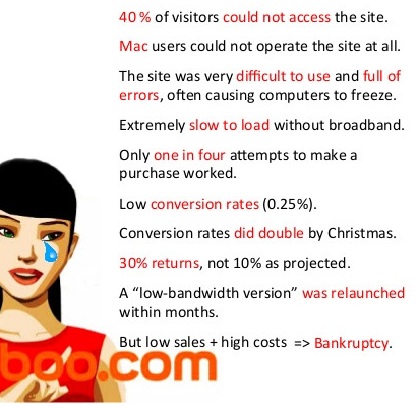Don't miss the chance to work with top 1% of developers.
Sign Up Now and Get FREE CTO-level Consultation.
Confused about your business model?
Request a FREE Business Plan.
6 Lessons You Can Learn from Boo.com – a failed eCommerce Business Plan
Table of contents

With the tremendous competition out in the market, setting up an eCommerce business was not and will never be an easy task. With the goal for you to succeed as an entrepreneur and deal with your eCommerce business adequately, you’ll have to figure out why most of the eCommerce businesses fall flat.
Starting an online business can be relatively easy, fast, and less expensive. However, with something like an 80% failure rate, making it a fruitful one is more challenging than a few people can imagine.
While each new business is unique, there are some common pitfalls that lead to eCommerce business failures. Understanding these pitfalls can help you with to avoid them and beat the record. To help you find these pitfalls, here is the story of an eCommerce website Boo.com failure which was closed in less than a year after its launch in spite of having millions in funding.
The boo.com case remains an important case study for a wide range of businesses since it doesn’t just highlight the difficulties of managing eCommerce development for a garments retailer, but instead highlights failings in management and strategy that can be made in any sort of organization.
Also Read: Why 99 Dresses – an eCommerce Business with a Brilliant Idea Failed?
What Was Boo.com – a failed Global eCommerce Website
When boo.com was launched in 1998, its three founders were at that time famous business tycoons because of selling their successful online bookseller website bokus.com. Boo.com was bound to be their next example of success: the first eCommerce retailer selling games equip and a trendy organization for the internet hungry Generation.
Boo.com’s 100 offices around the world had to shut down in 2000, after the organization, already in a spiral, couldn’t raise any more funds from its investors. After 18 years, we are as still discussing this failed eCommerce business, not just because it was fabulous but because the reasons behind its demise are immortal and a wakeup call for present-day entrepreneurs, marketers and startups.
When started, the valuation of the company was more than 200 million. At that time, it was a very big figure. But, in just eighteen months boo.com went bankrupt after burning all the money of investors. Here is what went wrong with an explanation of the same:

They Spent Fast and Died Young
Boo.com’s founders used £125 million in only a half year, to advertise itself as a global organization but then had to manage various issues like diverse languages, tax structure and pricing in nations it served. Their sales weren’t up to their desire, due to various reasons and the company died too early because of no funds left when their initial plan failed.
They Were Obsessed With Their Brand Identity
The marketing team at boo.com was often able to overrule the technical people. Even when it comes to taking the important technical ecommerce website development decisions, the marketing team used to make ones. Therefore, the organization made the most attractive looking website on the internet, with the poorest functionality.
Technical Problems Never Left
The founders of Boo.com concentrated excessively on a flashy and cutting-edge design for their website, which featured 3-D images and technology enabling clients to zoom in on various parts of a product. As a result, their website was tormented by technical problems and delays and took twice as long as expected to develop.
Lack of Market Researchers in the Team
At the time Boo.com launched, 20% of UK families had access to the internet and they were utilizing slow dial-up connections. It seems like the team at boo.com was not aware of this fact because they developed a heavy website that was not able to load on such a slow internet connection.
Also, anybody with a Macintosh PC (popular at that time) was also not able to utilize it. While Boo.com later balanced itself to permit users with slower connections and Macs to obtain access, the changes came too late.
Marketing Gone Wrong
No doubt, marketing is the most powerful pillar on which success of a business stands. But, when it goes wrong, everything vanishes. Boo.com marketed an ill product and that too excessively. Their marketing was lavish and expensive. Before boo.com even went on the web, more than 350,000 potential clients wanted to be notified of the website’s launch.
A big advertising and PR campaign, which accounted for millions of dollars, had effectively made a global brand of a store not even seen on the web yet. But, developing the website took much longer than expected. As a result, marketing expenditure continued spiraling and not a solitary sale was being made.
Key Takeaways from the Failure of Boo.com
1. Focus On What Your Clients Need
To attract their target audience, boo.com decided to provide the physical shopping experience online, including a virtual shopping assistant. No doubt it was a clever idea – but its implementation required complex programming, which just functioned admirably over a broadband connection (as specified above), while most clients still utilized a dial-up association around then. As a result, the users lost their patience with boo.com.
2. Spread Yourself Gradually
One of the fundamental factors that contributed to boo’s speedy demise was the choice to launch it in 18 different countries at the same time. A similar marketing campaign and website for every national market may have appeared to be a good idea to bind together a global brand identity, however, this misguided and costly strategy was turned into the original ‘how not to’ case for businesses trying to attract a global audience.
3. Always Go for Cost-effective Marketing
Towards the end of boo.com, the organization promoted a money-off plan. ‘The best methods of advertising the plan ended up being not costly online banners or newsletters advertising by emails,’ says boo co-founder Ernst Malmsten. This obvious acknowledgment came rather too late.
4. Ensure Your Ecommerce Website Works Everywhere
With any website, especially one for an eCommerce business, it is best to go for the lowest common denominator approach. That means the focus should be on mostly widely applicable circumstance or requirement. You have to make sure that your website works on every one of the devices smoothly in all circumstances.
5. Publicity Works Both Ways
If you put your brand under the media spotlight too soon, every mistake you commit will be noticed. Keep in mind that publicity is great just when it is defended. Unless you back it up with a strong brand performance it holds the potentials of betraying you.
6. Don’t Take Too Many Risks
Maintaining any eCommerce business can be costly. But, if your business profits are in the thousands, you should not spend millions in the hope that the deals will improve later on. Leave excessively hopeful and unsupportable forecasts to spiritualists and focus on the present reality.
Also read: Why Ecommerce Videos Are Important For Your Business?
Final Words
Boo was an incredible brand. But, still it failed. What we can learn from its story is that branding is about more than just looking good. It is about fulfilling promises. The promises boo made – both to its customers and investors – were at last undelivered. Now boo’s image is no more of a global brand but of a failed brand. And with its negative example, it has helped us to learn the true value of branding on the Internet and choose the best eCommerce mobile app builder.
Rate this article!
(25 ratings, average: 4.16 out of 5)
Join 60,000+ Subscribers
Get the weekly updates on the newest brand stories, business models and technology right in your inbox.

Humane yet subtle, Naiya is a girl full of ideas about almost everything. After earning a bachelor’s degree in computer science and engineering, she decided to merge her technical knowledge with her passion for writing – to accomplish something interesting with the fusion. Her write-ups are usually based on technology, mobile apps, and mobile development platforms to help people utilize the mobile world in an efficient way. Besides writing, you can find her making dance videos on Bollywood songs in a corner.

App Monetization Strategies: How to Make Money From an App?
Your app can draw revenue in many ways. All you need to figure out is suitable strategies that best fit your content, your audience, and your needs. This eGuide will put light on the same.
Download Now!Have a Digital Solution ? Don’t Let It Fail.
Make your solutions future ready by using the right tech stack.

















